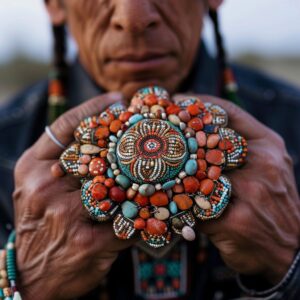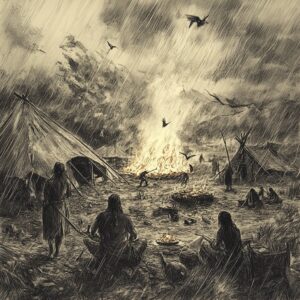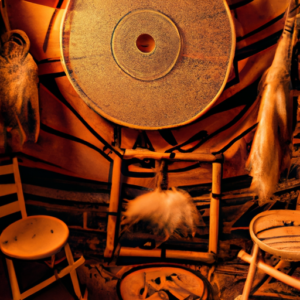Celebrating the Hunt Through Dance How Apache Hunters Used Sacred Dance Movements to Give Thanks for a Successful Hunt
Introduction
As the fiery sun dipped below the rugged horizon, casting an amber glow across the desert, a group of Apache hunters returned triumphantly to their camp. The air buzzed with anticipation, as women and children gathered to welcome the brave warriors back from a successful hunt. In the Apache tradition, the hunt was more than a means of survival; it was sacred, a spiritual connection to the lands that provided for them. To honor this connection and express gratitude, the Apache turned to the power of dance.
Apache hunters viewed each hunt not as an isolated event, but as a part of the delicate balance with nature. Before embarking on their quest, they prepared with rituals that sought guidance and permission from the spirits. Once their quarry was secured, the hunters celebrated through intricate dances, each step a meaningful gesture of thanks to the animals spirits and the earth. E sacred movements were passed down through generations, preserving the stories and wisdom of their ancestors.
The dances themselves were rich in symbolism and varied according to the tribe and occasion. Some steps mimicked the movements of the hunted animals, a graceful homage to their agility and spirit. Others incorporated elements of nature, reflecting the interconnectedness of all living things. Sacred songs accompanied these dances, their haunting melodies echoing across the canyons, a testament to the enduring gratitude of the Apache people.
Through dance, Apache hunters celebrated unity with their community and reaffirmed their bond with nature. The rhythmic beats and fluid movements were not merely performances, but cherished expressions of identity and culture. By embracing these traditions, they honored the past while ensuring the vitality and sustainability of their way of life. Dance, much like the hunt itself, was a powerful symbol of resilience, respect, and reverence for the world that sustained them.
Historical Context
The Apache people, known for their deep connection to nature and skilled hunting techniques, historically used dance as a spiritual expression of gratitude and respect. Apache culture, rich in tradition and wisdom, emphasized the harmony between humans and the natural world. For the Apache, hunting was more than a means of survival; it was a sacred endeavor. Celebrating a successful hunt through dance reflected their reverence and understanding of this profound relationship.
Within Apache history, rituals and ceremonies played vital roles in maintaining the balance necessary for a prosperous community. These dances, often held after a hunt, helped honor both the animals taken and the hunters’ role. They incorporated sacred movements that symbolized the circle of life and the interconnectedness of all beings. This spiritual act of Thanksgiving fostered community unity and shared gratitude, reinforcing cultural values deeply rooted in natures cycles.
The intricate gestures of the Apache dances were inspired by animal movements and the natural environment, blending storytelling with ceremonial purpose. Each performance served as a narrative, recounting the hunt and the skills displayed by the hunters. Through these dances, Apache wisdom emphasized teaching and preserving knowledge across generations. Sustenance provided by the hunt was cherished, with the dance serving as a bridge between the physical and spiritual realms.
The earth loves our people more than a mother loves her child. Lent to us, it will not be stolen. — Apache Proverb
Incorporating traditional music and song, these dances united the community in celebration and reflection. The rhythmic beats and chants provided a spiritual atmosphere, allowing participants to connect with ancestral spirits. By honoring their ancestral roots and the natural gifts bestowed upon them, the Apache ensured their cultural traditions thrived. The celebratory nature of these dances highlighted the Apache belief in lives cyclical nature and the bounty the earth provided.
Apache Hunt Celebration Dance Ritual
An Apache Story
The Apache people, renowned for their deep connection to nature, often expressed gratitude through sacred dance. Hunting was not merely a means of survival but a revered act that required skill, patience, and respect for the land. After a successful hunt, the Apache community would gather to celebrate through ritualistic movements, honoring the animals spirit and acknowledging the sustenance it provided. E dances were imbued with symbolism, each step and gesture a prayer and a mark of respect for the natural world. Such moments reinforced the harmony between the Apache people and their environment.
A central aspect of these dances was the acknowledgment of the hunters skill and the communities interdependence. Apache wisdom teaches that every hunt is a collective effort, with each member playing a vital role in preparation, execution, and celebration. Dance served as a moment to unite the tribe, blending storytelling with rhythm and movement. Through the dancers, the spirit of the hunt came alive, celebrated by all present. This communal dance fostered a sense of unity and gratitude.
One hunter might say,
We dance not just for the animal we have taken, but for the life it gives us.
This phrase captures the essence of their beliefs, illustrating the reverence the Apache held for all living things. Through dance, these celebrations became a living tradition, passed down through generations, teaching young ones the importance of balance and respect.
The ritual dances often incorporated elements of the hunt itself. Movements mirrored the stalking of prey, the arrows flight, and the moment of triumph. In these physical expressions, the Apache hunters shared tales of bravery and skill, inspiring all who watched. Each dancer contributed their own flair, reminding the community of the individuality within the collective. These dances became a canvas showcasing both the strength of the hunter and the bounty of the land.
At the heart of these celebrations was a profound gratitude, a cornerstone of Apache culture. The dance expressed thanks not only to the natural world but also to each other, emphasizing the importance of cooperation and shared success. This sense of gratitude extended beyond words, conveyed through the rhythm and energy that pulsated through each step. By celebrating the hunt through dance, the Apache reinforced their spiritual beliefs and ensured the continuity of their cultural heritage. These sacred movements became a testament to their enduring respect for nature and community.
Under the vast, starry night of the Apache lands, a crackling fire cast dancing shadows on the ground. An elder named Bimini, with wisdom woven into every wrinkle, sat surrounded by eager young faces. They leaned in, eager to hear the story of how dance ties them to their ancestors and the land.
The Hunt Begins
Listen closely, began Bimini, his voice rich with the rhythm of the earth. Once, in the time of our forefathers, the young hunter Shasta ventured into the wilderness. The morning air was crisp with a hint of pine, and each step Shasta took was like a whisper against the forest floor. His eyes scanned the horizon, seeking the creatures that would sustain his tribe.
Shasta moved with the grace of a mountain lion, silent and alert, listening to the rustle of leaves and the call of distant birds. As he tracked a herd of deer, he remembered his elders teaching. Every hunt is a conversation with nature; approach it with respect, Bimini had said. This thought grounded him as the deer came into view, majestic against the morning light.
A Dance of Gratitude
Later, as the sun dipped behind the hills, Shasta returned to the village, his heart full of gratitude. It was time to honor the spirit of the hunt through dance, a sacred tradition passed down through generations. It is not just a dance, but a prayer, Bimini explained, as the villagers gathered. Every movement is a thank you to our ancestors and the life given by the hunt.
Luck, a spirited young dancer, led the way, her movements embodying the swift grace of the animals and the soothing flow of the wind. Firelight flickered on their faces, each dancer’s expression a blend of joy and solemnity. Shasta joined in, his feet moving with the rhythm of the drum, feeling each beat connect him deeper to his roots.
Lessons from the Elders
As the night wore on, and the dance concluded, Bimini gathered the young ones close. What truth does this dance teach us? Bimini asked, his eyes twinkling with the wisdom of ages. Shasta, though exhausted, felt a new understanding take root. It teaches us respect and acknowledgment for all that sustains us, he replied.
Bimini nodded, his heart swelling with pride. Indeed, we honor not just the hunt and the hunter, but the entire cycle of life. In every beat, we find connection. As the fire embers dimmed, each youth carried a flicker of that flame, a commitment to uphold traditions with reverence.
Do you feel the rhythms in your own life that call you to express gratitude and connection? Consider how you might honor the cycles that sustain you every day.
Practical Applications
Implementing the Principles of Celebrating the Hunt Through Dance in Daily Life
The Apache people have long celebrated successful hunts through sacred dance movements, connecting deeply with nature and expressing gratitude. By incorporating these principles into your daily life, you can cultivate a sense of mindfulness and appreciation. Here’s a step-by-step guide to help you integrate these practices.
- Create a Quiet Space: Designate a small area in your home where you can mentally and physically prepare for a dance or reflective session. This could be a corner with a mat and some calming elements like plants or incense. A quiet environment allows you to focus solely on the practice without distractions.
- Set an Intention: Before starting, decide on an intention for your dance session. This could be something as simple as expressing gratitude or seeking strength. Setting an intention aligns your movements with a purpose, much like the Apache hunters did after a successful hunt.
- Learn Simple Dance Movements: Begin with simple, repetitive movements that resonate with you. The idea is not complexity but rather finding a rhythm that relaxes and engages you. Consider researching traditional Apache dance movements for inspiration.
- Incorporate Nature: Whenever possible, perform these dances outside or bring elements of nature like stones or feathers into your space. Apache dances were deeply connected to nature, celebrating and giving thanks to the land.
- Practice Mindfulness: Focus entirely on your movements and the intention behind them. Let go of any other thoughts and be fully present. The Apache hunters used this time not only to celebrate but also to connect spiritually with their achievements.
- Reflect Afterward: Take a few minutes to sit quietly after the session, reflecting on what you felt during the dance. This reflection solidifies the intentions and experiences, helping you integrate the joy and gratitude into your daily life.
- Share with Others: If comfortable, share your experience with friends or family. Inviting someone to join you can enhance the experience and foster a deeper communal appreciation, similar to how the Apache community would gather for celebrations.
Potential Challenges and How to Overcome Them
Finding time for a new practice can be challenging. Start with short sessions and gradually extend the duration as you become more comfortable. If you feel self-conscious about dancing, remember that it’s a personal expression and there’s no right or wrong way. Embrace the process and your unique style.
Tips for Maintaining Consistency
Schedule regular times each week dedicated to this practice, integrating it into your routine like a meal or exercise. Remind yourself of the benefits you feel after a session to keep motivation high. Setting a calendar reminder or writing a journal about your experiences can also reinforce the habit.
Have you ever considered how incorporating ritualistic movement into your life could enhance your daily routine? Try introducing even a simple version of this practice and observe how it impacts your sense of gratitude and connection.
Apache Hunt Celebration Dance Ritual
Conclusion
The Apaches rich tradition of celebrating the hunt through dance offers a profound glimpse into their deep bond with nature and respect for the sustenance provided by the land. Through sacred dance movements, Apache hunters expressed gratitude, acknowledging the spiritual connection between themselves and the animals they hunted. This ancient wisdom encourages reflection on our modern approach to nature and the ecosystems that support us.
As we delve into these traditions, it becomes evident how dance served not only as a means of celebration but also as an integral part of community life, fostering unity and shared purpose. Communal aspect of these dances reinforced the values of gratitude and respect, reminding us of the importance of giving thanks and celebrating each step of the journey. Embracing such cultural wisdom can inspire a renewed appreciation for nature and shared cultural experiences.
The story of Apache hunters and their sacred dances beckons us to integrate similar values into our lives, appreciating the intricate connections between humans and nature. Let us embrace this wisdom, cultivating gratitude and mindfulness in our interactions with the environment. By doing so, we honor not only the tradition of the Apache but also the larger tapestry of life that sustains us all.
Consider participating in cultural events or learning about indigenous practices that emphasize harmony with nature. Engage with community groups that celebrate similar traditions to keep these meaningful practices alive. Such efforts can lead to a deeper understanding and appreciation of cultural heritage, ultimately fostering a more sustainable and harmonious existence.
More Resources
Dive deeper into the fascinating world of Apache wisdom and its modern applications. Explore these thought-provoking questions to expand your understanding of the concepts discussed in this article.
Explore Further with Google
- How can we practice earth-based spirituality in our education systems?
- How can we integrate indigenous wisdom in our environmental challenges?
- How can we practice ethnobotany in our mental health?
Discover Insights with Perplexity
- What role do cultural traditions play in contemporary mindfulness?
- How can we preserve holistic healing in our intergenerational knowledge?
- What ancient healing practices are being rediscovered by modern medicine?
By exploring these questions, you’ll gain a richer appreciation for indigenous cultures, environmental stewardship, and mindfulness practices. Each link opens a gateway to deeper knowledge, helping you connect ancient wisdom with contemporary life.
Thank you for reading!







